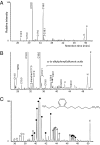Ancient lipids reveal continuity in culinary practices across the transition to agriculture in Northern Europe
- PMID: 22025697
- PMCID: PMC3207664
- DOI: 10.1073/pnas.1107202108
Ancient lipids reveal continuity in culinary practices across the transition to agriculture in Northern Europe
Abstract
Farming transformed societies globally. Yet, despite more than a century of research, there is little consensus on the speed or completeness of this fundamental change and, consequently, on its principal drivers. For Northern Europe, the debate has often centered on the rich archaeological record of the Western Baltic, but even here it is unclear how quickly or completely people abandoned wild terrestrial and marine resources after the introduction of domesticated plants and animals at ∼4000 calibrated years B.C. Ceramic containers are found ubiquitously on these sites and contain remarkably well-preserved lipids derived from the original use of the vessel. Reconstructing culinary practices from this ceramic record can contribute to longstanding debates concerning the origins of farming. Here we present data on the molecular and isotopic characteristics of lipids extracted from 133 ceramic vessels and 100 carbonized surface residues dating to immediately before and after the first evidence of domesticated animals and plants in the Western Baltic. The presence of specific lipid biomarkers, notably ω-(o-alkylphenyl)alkanoic acids, and the isotopic composition of individual n-alkanoic acids clearly show that a significant proportion (∼20%) of ceramic vessels with lipids preserved continued to be used for processing marine and freshwater resources across the transition to agriculture in this region. Although changes in pottery use are immediately evident, our data challenge the popular notions that economies were completely transformed with the arrival of farming and that Neolithic pottery was exclusively associated with produce from domesticated animals and plants.
Conflict of interest statement
The authors declare no conflict of interest.
Figures




References
-
- Whittle A, Cummings V, editors. Going Over: The Mesolithic-Neolithic Transition in North-West Europe, Proceedings of the British Academy. Vol 144. Oxford: Oxford University Press; 2007.
-
- Bellwood P, Renfrew C. Examining the Farming/Language Dispersal Hypothesis. Cambridge: McDonald Institute for Archaeological Research; 2002.
-
- Fischer A, Kristiansen K, editors. The Neolithisation of Denmark: 150 Years of Debate. Oxford: Oxbow; 2002.
-
- Rowley-Conwy P. How the west was lost: A reconsideration of agricultural origins in Britain, Ireland, and Southern Scandinavia. Curr Anthropol. 2004;45(S4):S83-S113–S183-S113.
Publication types
MeSH terms
Substances
LinkOut - more resources
Full Text Sources

